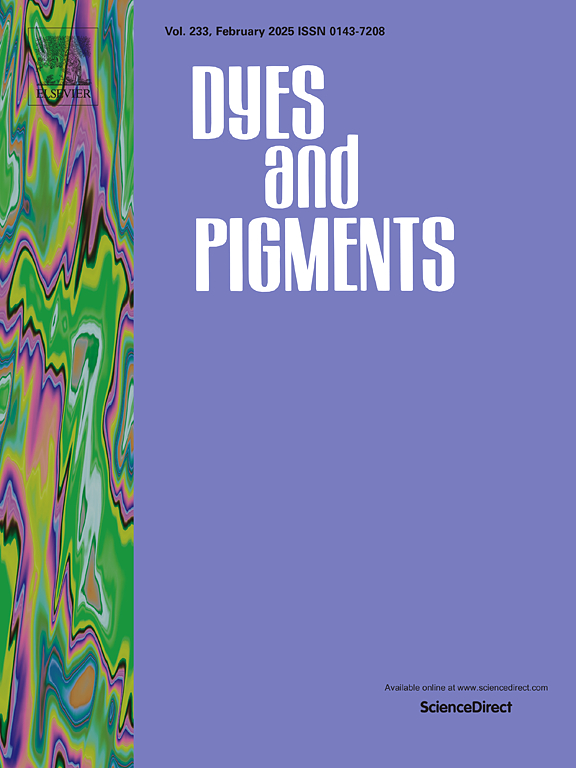Four Anderson-type POM-based viologen compounds for information encryption and food freshness detection
IF 4.1
3区 工程技术
Q2 CHEMISTRY, APPLIED
引用次数: 0
Abstract
In this paper, Anderson-type polyoxometalates (POMs) were combined with a viologen ligand to synthesize four compounds under solvothermal conditions, namely (1,3–bcbby)3·(TeMo6O24)⋅5H2O (1),(1,3–bcbby)·[M2(H2O)6TeMo6O24] (2: M = Zn; 3: M = Ni; 4: M = Cu) (1,3-bcbby·2Cl = 1,1′-bis(3-carboxybenzyl)-4,4′-bipyridine dichloride). Compound 1 forms one-dimensional supramolecular chains and two-dimensional supramolecular layers through hydrogen bondings. Isomorphic compounds 2−4 form one-dimensional inorganic chains through covalent bonds between metal ions and POMs, which were then organized into two-dimensional layered structures through hydrogen bondings. All four compounds can be used as color-changing materials. Among them, compounds 1 and 2 exhibit pronounced reversible photochromic properties under a xenon lamp irradiation, while compounds 3 and 4 show good thermochromic properties. Capitalizing on the prompt response of compounds 1 and 2 to ultraviolet light, they are utilized on filter paper for application in ink-free erasable printing. Additionally, when these four compounds are exposed to atmospheres containing ammonia, ethylenediamine or diethylenetriamine, they exhibit distinct color changes. Based on this character, compound 2 was formulated into a portable amine detection strip, which can detect the freshness of pork in real-time through color changes of the detection strip.

用于信息加密和食品新鲜度检测的四种安德森型pom基紫素化合物
本文将anderson型多金属氧酸酯(pom)与紫红素配体结合,在溶剂热条件下合成了(1,3 - bcbby)3·(TeMo6O24)·5H2O(1)、(1,3 - bcbby)·[M2(H2O)6TeMo6O24] (2: M = Zn;3: M = Ni;4: M = Cu) (1,3- bcby·2Cl = 1,1 ' -双(3-羧基苄基)-4,4 ' -二氯化联吡啶)。化合物1通过氢键形成一维超分子链和二维超分子层。同形化合物2−4通过金属离子与pom之间的共价键形成一维无机链,然后通过氢键组织成二维层状结构。这四种化合物都可以用作变色材料。其中化合物1和2在氙灯照射下表现出明显的可逆光致变色性能,化合物3和4表现出良好的热致变色性能。利用化合物1和2对紫外光的快速反应,它们被用在滤纸上,用于无墨可擦印刷。此外,当这四种化合物暴露于含有氨、乙二胺或二乙三胺的大气中时,它们会表现出明显的颜色变化。根据这一特性,将化合物2配制成一种便携式胺检测条,通过检测条的颜色变化实时检测猪肉的新鲜度。
本文章由计算机程序翻译,如有差异,请以英文原文为准。
求助全文
约1分钟内获得全文
求助全文
来源期刊

Dyes and Pigments
工程技术-材料科学:纺织
CiteScore
8.20
自引率
13.30%
发文量
933
审稿时长
33 days
期刊介绍:
Dyes and Pigments covers the scientific and technical aspects of the chemistry and physics of dyes, pigments and their intermediates. Emphasis is placed on the properties of the colouring matters themselves rather than on their applications or the system in which they may be applied.
Thus the journal accepts research and review papers on the synthesis of dyes, pigments and intermediates, their physical or chemical properties, e.g. spectroscopic, surface, solution or solid state characteristics, the physical aspects of their preparation, e.g. precipitation, nucleation and growth, crystal formation, liquid crystalline characteristics, their photochemical, ecological or biological properties and the relationship between colour and chemical constitution. However, papers are considered which deal with the more fundamental aspects of colourant application and of the interactions of colourants with substrates or media.
The journal will interest a wide variety of workers in a range of disciplines whose work involves dyes, pigments and their intermediates, and provides a platform for investigators with common interests but diverse fields of activity such as cosmetics, reprographics, dye and pigment synthesis, medical research, polymers, etc.
 求助内容:
求助内容: 应助结果提醒方式:
应助结果提醒方式:


